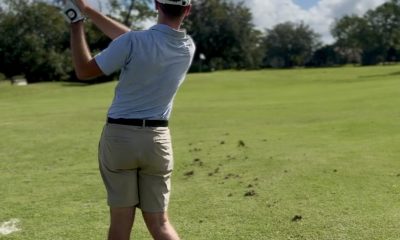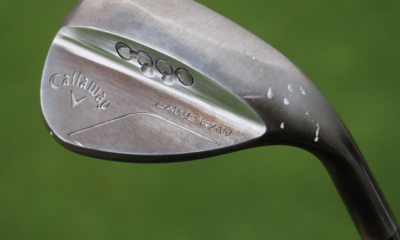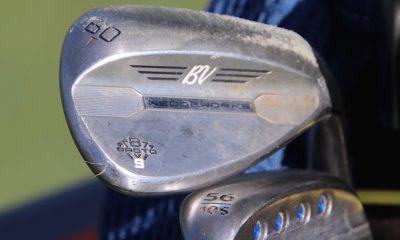Instruction
5 keys to flighting your wedges lower for better control

If you watch the best players in the world hit wedges, you’ll see them frequently using a shot that most amateurs don’t have. It’s called a “flighted” wedge, and it flies with a lower-than-normal trajectory and usually moves from right-to-left (for righties) into the pin. This is helpful because the lower ball flight stays below the wind, improves consistency and offers more spin. It’s a shot that can take an average wedge game to the next level.
Below are my 5 keys to flighting your wedges for better control.
1) Maintain a Consistent Angle of Attack
The best wedge players nip the ground with their wedges, only “bruising” it, not spending their day on the course carving up pork chops. That’s because their angle of attack (AoA) isn’t overly steep and their swing mechanics allow them to re-create a desirable impact position (an AoA that’s a few degrees downward to ensure clean contact) time after time.
All golfers golfer should aim to take shallow divots like tour players, but getting a little steeper is OK so long as you’re consistent. You want the ball to launch in the same “window” with a predictable trajectory and amount of spin when the ball hits the green.
2) Control your Dynamic Loft
The loft of the club at impact is called dynamic loft, and if you want to lower the flight of your golf ball you will need to reduce it. If you lean the shaft forward too much at impact, however, you will reduce your trajectory to a point that the landing angle of the ball is too flat and no amount of spin you produce will make the ball stop or spin back. This factor is the most difficult one for most amateurs to control, so you will need to practice.
3) Reduce the Overall Height of the Ball Flight
As stated above, if you decrease the dynamic loft you will decrease launch angle and the overall height will be affected. Take this with a grain of sand. We desire a “flatter” ball flight, not a head-high screaming bullet into the green. You know what your normal peak trajectory looks like (around 75-90 feet for most golfers) with your wedges, so make sure it is a touch more flighted than your full-shot height.
4) Manage Spin Rates
The spin rate of the ball will influence its landing action on the green. It makes no sense to spin one shot at 10,000 rpm and the other at 6,000 rpm from the same distance. The point of flighting a wedge is consistency, not adding variance.
The key to a consistent spin rate, assuming your mechanics are solid, is keeping your wedge face and grooves clean and making contact on the same part of your club face time after time. The next time you’re practicing using your favorite launch monitor, make sure to keep an eye on the spin rate and try to keep it in a tight range.
5) Move the Ball into the Pin from Right to Left
First, I want to thank Mike Bender. He taught me the aspects of moving your wedge shots into the green from right-to-left and why you should do it.
He and Zach Johnson worked on this before Zach won The Masters, and it was one of the keys to his success. Most greens are pitched from back to front, so if you hit the ball into the pin from right to left and land the ball right of the pin, the ball will land, hop and spin back, moving toward the hole instead of away from it. When the ball stops, you’re also more likely to have an uphill, right-to-left putt, which is statistically the easiest putt to make for right-handed players.
To move the ball from right to left with your wedges your club path must be right of your face angle at impact. Pay attention to your starting direction and make sure the ball is beginning a little to the right of the pin so you can move the ball towards the pin, not away from it.
The Numbers
Let’s take a look at what a flighted wedge shot looks on Trackman so I can show you what the numbers should look like. One thing I like about the latest Trackman software (TPS 4.1) is the ability to see my average number within each data point, as well as the plus-minus difference between all my shots; it helps me chart how tight my tolerances are in each category.
Here is a screenshot of my “flighted” wedge practice session.

You can click/tap the image to enlarge it.
The big numbers in each category are for the last shot hit, while the smaller numbers (on the left) are the averages for the 15 or so shots I hit for this article.
Angle of Attack
My AoA is right about -7 degrees, which is OK for this shot. As you can see, it was a very consistent data point at only 0.8 degrees of difference. I would prefer to have a slightly less downward AoA, but at least it’s consistent.
Dynamic Loft
My dynamic loft on this shot was 38.9 degrees with my 54-degree wedge. While this might look good, it represents too little loft for my needs. As stated above, when you hit down too much on the ball you’ll tend to also lean the shaft too far forward. If I shallow out my AoA, the dynamic loft will fall more inline with what I’d like it to become.
Height
I’m pleased with the overall height of my shots, though the AoA and Dynamic Loft ranges were a touch off. The height of my shots stayed relatively consistent at 43.4 feet (my shot traveled about 75 yards on average) with a variance of only 3.5 feet. At least I will have a consistent shot reaction from the golf ball when it hits the green.
Spin
I am not as concerned with the overall rotations per minute, but the rather the consistency of them. My average spin rate was 4760 rpm (not too bad for the range balls I was hitting), but I was concerned with my range at 1142 rpm. As you can see, I hit too many short and spinny wedge shots that didn’t go as far as the others, radically affecting the overall spin consistency. I must stay “down” a touch longer though impact for this to subside.
Face-to-Path
The value here was -4.6 and the consistency was +/- 1.6 degrees, showing me that most of my shots were moving in the direction that I’d like them to be moving. It’s easy to “hang” wedges or overcook them when you don’t practice, so this isn’t too bad for me.

So it’s off to the lesson tee for me to make sure I can do this without hitting down on the ball too much. Learn how to flight your wedges, your scores will thank you!
Instruction
The Wedge Guy: Beating the yips into submission

There may be no more painful affliction in golf than the “yips” – those uncontrollable and maddening little nervous twitches that prevent you from making a decent stroke on short putts. If you’ve never had them, consider yourself very fortunate (or possibly just very young). But I can assure you that when your most treacherous and feared golf shot is not the 195 yard approach over water with a quartering headwind…not the extra tight fairway with water left and sand right…not the soft bunker shot to a downhill pin with water on the other side…No, when your most feared shot is the remaining 2- 4-foot putt after hitting a great approach, recovery or lag putt, it makes the game almost painful.
And I’ve been fighting the yips (again) for a while now. It’s a recurring nightmare that has haunted me most of my adult life. I even had the yips when I was in my 20s, but I’ve beat them into submission off and on most of my adult life. But just recently, that nasty virus came to life once again. My lag putting has been very good, but when I get over one of those “you should make this” length putts, the entire nervous system seems to go haywire. I make great practice strokes, and then the most pitiful short-stroke or jab at the ball you can imagine. Sheesh.
But I’m a traditionalist, and do not look toward the long putter, belly putter, cross-hand, claw or other variation as the solution. My approach is to beat those damn yips into submission some other way. Here’s what I’m doing that is working pretty well, and I offer it to all of you who might have a similar affliction on the greens.
When you are over a short putt, forget the practice strokes…you want your natural eye-hand coordination to be unhindered by mechanics. Address your putt and take a good look at the hole, and back to the putter to ensure good alignment. Lighten your right hand grip on the putter and make sure that only the fingertips are in contact with the grip, to prevent you from getting to tight.
Then, take a long, long look at the hole to fill your entire mind and senses with the target. When you bring your head/eyes back to the ball, try to make a smooth, immediate move right into your backstroke — not even a second pause — and then let your hands and putter track right back together right back to where you were looking — the HOLE! Seeing the putter make contact with the ball, preferably even the forward edge of the ball – the side near the hole.
For me, this is working, but I am asking all of you to chime in with your own “home remedies” for the most aggravating and senseless of all golf maladies. It never hurts to have more to fall back on!
Instruction
Looking for a good golf instructor? Use this checklist

Over the last couple of decades, golf has become much more science-based. We measure swing speed, smash factor, angle of attack, strokes gained, and many other metrics that can really help golfers improve. But I often wonder if the advancement of golf’s “hard” sciences comes at the expense of the “soft” sciences.
Take, for example, golf instruction. Good golf instruction requires understanding swing mechanics and ball flight. But let’s take that as a given for PGA instructors. The other factors that make an instructor effective can be evaluated by social science, rather than launch monitors.
If you are a recreational golfer looking for a golf instructor, here are my top three points to consider.
1. Cultural mindset
What is “cultural mindset? To social scientists, it means whether a culture of genius or a culture of learning exists. In a golf instruction context, that may mean whether the teacher communicates a message that golf ability is something innate (you either have it or you don’t), or whether golf ability is something that can be learned. You want the latter!
It may sound obvious to suggest that you find a golf instructor who thinks you can improve, but my research suggests that it isn’t a given. In a large sample study of golf instructors, I found that when it came to recreational golfers, there was a wide range of belief systems. Some instructors strongly believed recreational golfers could improve through lessons. while others strongly believed they could not. And those beliefs manifested in the instructor’s feedback given to a student and the culture created for players.
2. Coping and self-modeling can beat role-modeling
Swing analysis technology is often preloaded with swings of PGA and LPGA Tour players. The swings of elite players are intended to be used for comparative purposes with golfers taking lessons. What social science tells us is that for novice and non-expert golfers, comparing swings to tour professionals can have the opposite effect of that intended. If you fit into the novice or non-expert category of golfer, you will learn more and be more motivated to change if you see yourself making a ‘better’ swing (self-modeling) or seeing your swing compared to a similar other (a coping model). Stay away from instructors who want to compare your swing with that of a tour player.
3. Learning theory basics
It is not a sexy selling point, but learning is a process, and that process is incremental – particularly for recreational adult players. Social science helps us understand this element of golf instruction. A good instructor will take learning slowly. He or she will give you just about enough information that challenges you, but is still manageable. The artful instructor will take time to decide what that one or two learning points are before jumping in to make full-scale swing changes. If the instructor moves too fast, you will probably leave the lesson with an arm’s length of swing thoughts and not really know which to focus on.
As an instructor, I develop a priority list of changes I want to make in a player’s technique. We then patiently and gradually work through that list. Beware of instructors who give you more than you can chew.
So if you are in the market for golf instruction, I encourage you to look beyond the X’s and O’s to find the right match!
Instruction
What Lottie Woad’s stunning debut win teaches every golfer

Most pros take months, even years, to win their first tournament. Lottie Woad needed exactly four days.
The 21-year-old from Surrey shot 21-under 267 at Dundonald Links to win the ISPS Handa Women’s Scottish Open by three shots — in her very first event as a professional. She’s only the third player in LPGA history to accomplish this feat, joining Rose Zhang (2023) and Beverly Hanson (1951).
But here’s what caught my attention as a coach: Woad didn’t win through miraculous putting or bombing 300-yard drives. She won through relentless precision and unshakeable composure. After watching her performance unfold, I’m convinced every golfer — from weekend warriors to scratch players — can steal pages from her playbook.
Precision Beats Power (And It’s Not Even Close)
Forget the driving contests. Woad proved that finding greens matters more than finding distance.
What Woad did:
• Hit it straight, hit it solid, give yourself chances
• Aimed for the fat parts of greens instead of chasing pins
• Let her putting do the talking after hitting safe targets
• As she said, “Everyone was chasing me today, and managed to maintain the lead and played really nicely down the stretch and hit a lot of good shots”
Why most golfers mess this up:
• They see a pin tucked behind a bunker and grab one more club to “go right at it”
• Distance becomes more important than accuracy
• They try to be heroic instead of smart
ACTION ITEM: For your next 10 rounds, aim for the center of every green regardless of pin position. Track your greens in regulation and watch your scores drop before your swing changes.
The Putter That Stayed Cool Under Fire
Woad started the final round two shots clear and immediately applied pressure with birdies at the 2nd and 3rd holes. When South Korea’s Hyo Joo Kim mounted a charge and reached 20-under with a birdie at the 14th, Woad didn’t panic.
How she responded to pressure:
• Fired back with consecutive birdies at the 13th and 14th
• Watched Kim stumble with back-to-back bogeys
• Capped it with her fifth birdie of the day at the par-5 18th
• Stayed patient when others pressed, pressed when others cracked
What amateurs do wrong:
• Get conservative when they should be aggressive
• Try to force magic when steady play would win
• Panic when someone else makes a move
ACTION ITEM: Practice your 3-6 foot putts for 15 minutes after every range session. Woad’s putting wasn’t spectacular—it was reliable. Make the putts you should make.
Course Management 101: Play Your Game, Not the Course’s Game
Woad admitted she couldn’t see many scoreboards during the final round, but it didn’t matter. She stuck to her game plan regardless of what others were doing.
Her mental approach:
• Focused on her process, not the competition
• Drew on past pressure situations (Augusta National Women’s Amateur win)
• As she said, “That was the biggest tournament I played in at the time and was kind of my big win. So definitely felt the pressure of it more there, and I felt like all those experiences helped me with this”
Her physical execution:
• 270-yard drives (nothing flashy)
• Methodical iron play
• Steady putting
• Everything effective, nothing spectacular
ACTION ITEM: Create a yardage book for your home course. Know your distances to every pin, every hazard, every landing area. Stick to your plan no matter what your playing partners are doing.
Mental Toughness Isn’t Born, It’s Built
The most impressive part of Woad’s win? She genuinely didn’t expect it: “I definitely wasn’t expecting to win my first event as a pro, but I knew I was playing well, and I was hoping to contend.”
Her winning mindset:
• Didn’t put winning pressure on herself
• Focused on playing well and contending
• Made winning a byproduct of a good process
• Built confidence through recent experiences:
- Won the Women’s Irish Open as an amateur
- Missed a playoff by one shot at the Evian Championship
- Each experience prepared her for the next
What this means for you:
• Stop trying to shoot career rounds every time you tee up
• Focus on executing your pre-shot routine
• Commit to every shot
• Stay present in the moment
ACTION ITEM: Before each round, set process goals instead of score goals. Example: “I will take three practice swings before every shot” or “I will pick a specific target for every shot.” Let your score be the result, not the focus.
The Real Lesson
Woad collected $300,000 for her first professional victory, but the real prize was proving that fundamentals still work at golf’s highest level. She didn’t reinvent the game — she simply executed the basics better than everyone else that week.
The fundamentals that won:
• Hit more fairways
• Find more greens
• Make the putts you should make
• Stay patient under pressure
That’s something every golfer can do, regardless of handicap. Lottie Woad just showed us it’s still the winning formula.
FINAL ACTION ITEM: Pick one of the four action items above and commit to it for the next month. Master one fundamental before moving to the next. That’s how champions are built.
PGA Professional Brendon Elliott is an award-winning coach and golf writer. You can check out his writing work and learn more about him by visiting BEAGOLFER.golf and OneMoreRollGolf.com. Also, check out “The Starter” on RG.org each Monday.
Editor’s note: Brendon shares his nearly 30 years of experience in the game with GolfWRX readers through his ongoing tip series. He looks forward to providing valuable insights and advice to help golfers improve their game. Stay tuned for more Tips!






















Dill Pickleson
Feb 22, 2017 at 1:23 am
I like this article. It’s a guideline that I can reference. And, confirms my believe that a little right/left is good.
Sure, more time can be spent on HOW but you have to start somewhere, right?
T bone
Feb 20, 2017 at 9:14 am
As a +handicap and a fader of the golf ball, I completely agree with Tom about the draw for this particular golf shot. While the article doesn’t really instruct on how to do it without the launch monitor, the advise of hitting a slight (1-3yds) draw is KEY to LOW, CONSISTANT wedges. The phrase my instructor used to use is “coming in strong to the pin”. The draw matches the elements better of good wedge play, meaning it’s easier to compress the ball with only taking a SHALLOW divot. For me, trying to fade a wedge means I am going to take a ton more grass, my hands need to be ahead of the ball way too much causing inconsistency, the ball will fly slightly HIGHER with the fade, leaving more room for wind to effect the shot. Even if I do manage to hit the proper distance, the increased spin of the fade will have the ball zipping back instead of that nice couple hops and stop. If any of you have access to a grass range, try taking swings that barely brush the grass, I bet you will find that the more left you swing, the harder to do, especially when trying to press hands forward to hit lower shots. Bottom line, with the short (most important) clubs, a SLIGHT draw is the stronger shot that will leave you with better birdie ops. The high floater should only be used when needed.
Yessir
Feb 21, 2017 at 12:51 am
Literally 100% spot on about hitting low cuts and taking too much turf. Low draw wedges have always been my things, easy to stay shallow and keep dynamic loft down controlling the flight and spin. Really can’t do that moving the shaft leftward.
Dill Pickleson
Feb 22, 2017 at 1:18 am
nice post.
Golfwrx and chill
Feb 19, 2017 at 4:53 pm
Error 404: instruction not found
Fire left
Feb 18, 2017 at 8:12 pm
This article is terrible. Zero actual instruction. “If you want to hit controllable low wedges just flight it lower by having a tour pros swing plane and lowering dynamic loft. Oh and hit a draw.” Thanks Tom I’ll be wedging it like ZJ in no time!
Alex
Feb 18, 2017 at 7:55 pm
I agree with everything except the ball should be coming into the green left to right not right to left.
Jeff
Feb 18, 2017 at 6:43 pm
This is another awful article, plus the fact that you as a teaching pro can’t do it htf are amateurs that play once a week expected to do it.
Skip
Feb 18, 2017 at 11:56 am
“he next time you’re practicing using your favorite launch monitor, make sure to keep an eye on the spin rate and try to keep it in a tight range.”
Ya lol, ’cause we’ve all got one of those.
bogeypro
Feb 18, 2017 at 10:55 am
I like the data and the 5 points, but would have liked to have seen a little more instruction on how to hit the shots. Maybe a few practice drills instead of using a launch monitor that very few have access to play on.
david
Feb 18, 2017 at 8:47 am
There’s an easier way to practice hitting lower shots at the range: tie a string to 2 sticks, the strings about 2 feet off the ground, and put the sticks about 4 or 5 feet in front of you, and try to hit the ball under that string. You’ll learn how NOT to flip you wrists and hit it on a proper trajectory
Daniel Smith
Feb 21, 2017 at 11:56 am
These comments are so salty about instructions and launch monitors. This is EXACTLY the method I used at the range and with a couple sessions I was able to consistently hit this shot. If you don’t know enough about the golf swing to take his comments and apply them then you shouldn’t be attempting this shot. Just keep hitting high wedges uncontrollably.
You don’t need an LM to tell you spin/ball flight. 1. Move ball back in stance. 2. Look at your divot. 3. Look at your ball flight, it should be lower 4. Check the direction of the spin when the ball lands. HINT: it should move left.
Devilsadvocate
Feb 17, 2017 at 7:54 pm
Tom I have a TON of respect for you as an instructor and usually you articles are FANTASTIC…. but what is this??? Zero swing thoughts, moves, or adjustments to make to get the numbers you speak of… why don’t u shoot me DJS driver numbers while youre at it? Im sure ill be hitting it 350 in no time!
Joey5Picks
Feb 17, 2017 at 3:47 pm
“Take this with a grain of sand.” The phrase is actually “Take this with a grain of salt.”
Wizardofflatstickmountain
Feb 17, 2017 at 4:00 pm
Considering this is a golf site, you probably don’t find too many salt bunkers on the course…
Steve
Feb 17, 2017 at 8:53 pm
Did you at least hear the wind from the joke as it soared over your head?
Devilsadvocate
Feb 17, 2017 at 10:38 pm
+1
Cornwall1888
Feb 17, 2017 at 2:22 pm
Why do none of the instructions for this shot mention hitting it low on the face? that’s one of the main aspects of it and where most amateurs go wrong
Leftshot
Feb 17, 2017 at 2:15 pm
Some good stuff, but left out one of the biggest factors. This shot requires a smooth swing. If you watch the pros they are hitting smooth 1/2 to 3/4 swing shots with an abbreviated follow through. They are accelerating into the ball, but 50% effort is about the norm. The whole point of this shot is consistency and accuracy.
Important especially with amateurs. Most weekend golfer’s swings are a violent explosion and if they try to abbreviate the backswing, it’s an even more violent, abrupt transition. Because of this, the flighted shot requires practice, but has the added benefit of improving the player’s full swing if they transfer some of the skills learned here.
Acemandrake
Feb 18, 2017 at 9:21 am
Perfect
A smooth, shorter, unhurried arm swing with a quiet (but still slightly involved0 body rotation) works for me. This also makes it easier to repeat.
BONUS: You can practice this until the cows come home without getting tired.
#dialedin
Double Mocha Man
Feb 18, 2017 at 2:39 pm
What range do you practice at? That has cows?
Acemandrake
Feb 18, 2017 at 5:41 pm
You don’t want to know 🙂
MBU
Feb 17, 2017 at 2:11 pm
Hit it from right to left, with a draw? You’d be very likely to get a few shanks with that method, and in any case that piece of instruction is near pointless on many levels. But the rest of the article is sound advice.
Jeff
Feb 18, 2017 at 6:54 pm
So true
Jack
Mar 10, 2017 at 11:22 am
He’s talking about the ball flight.
tom stickney
Feb 17, 2017 at 1:44 pm
If you don’t have a launch monitor available you can always use something in the distance to audit your trajectory.
If the pin is on the right side of the green the obviously you wouldn’t move the ball in from right to left.
Jeffrey Purtell
Feb 18, 2017 at 2:52 am
What did golfers ever do before launch monitors????????????? I guess they just hit the ball already.
Jimmy Ray
Feb 17, 2017 at 12:36 pm
my “favorite launch monitor”? Yeah, that’s gonna be tough. I have sooooo many lying around my private, GN-1 seeded, 275-yard backyard practice facility…
Cmoregolf
Feb 17, 2017 at 12:31 pm
“not spending their day on the course carving up pork chops” Tell that to Jordan Spieth, his are the size of small parks.
Philip
Feb 17, 2017 at 12:25 pm
Go to the range and practice hitting lower flights until one finds a feel that works … at least that is my plan in 2 months
Rick
Feb 17, 2017 at 11:24 am
Hi Tom,
Thanks for sharing this information on how to hit low wedge shots. How do your students that don’t have access to a trackman practice this shot? Thanks.
F
Feb 17, 2017 at 11:15 am
Ah yes, let me just take my trackman out in my spare time to hit wedge shots.
Tim
Feb 17, 2017 at 10:06 am
So no actual info on how to hit this shot, k.
straightdriver235
Feb 17, 2017 at 9:18 am
To play this shot, acceleration into the ball is more controlled, and it’s almost as if the ball were caught on the upswing. The club is still moving down and from the right, but the body and hands have started to move into the follow through and to the left. Hitting down to much with de-lofted face will still spin the ball up, causing a balloon, and reduce chance of right to left.
C
Feb 17, 2017 at 8:34 am
About the ‘right to left’ thing… If a right-handed golfer draws the ball into the green, he/she will tend to end up on the left side of the green. This will leave uphill left to right putts, statistically harder putts to make.
J
Feb 17, 2017 at 9:42 am
Is the pin always in the dead center of the green?
AB
Feb 17, 2017 at 11:04 am
According to the article, yes and what if the pin is on the right side of the green should we still hit the R to L shot
Tom
Feb 18, 2017 at 5:27 pm
C ….” When the ball stops, you’re also more likely to have an uphill, right-to-left putt, which is statistically the easiest putt to make for right-handed players”